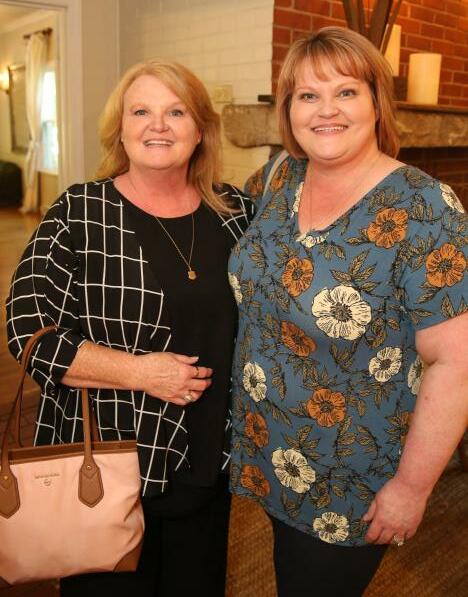5 minute read
STACEY STREETMAN CAMPAIGN KICK-OFF

Maria Haycraft, Stacey Streetman & O’Neal Wiggins Dwight & Jean Luton Gary & Joyce Norris


Dillan, Katelyn, Hunter & Maddie Streetman Kim Turner & Donna Windham

Story & Photography by Tony Centonze Stacey Streetman, Ward 10 Councilperson, officially kicked off her run for a second four-year term, with a reception at The Tanglewood House.
Dozens of supporters, friends, and family members enjoyed hors d’oeuvres and fellowship, “at the place where it all began, four years ago,” Streetman said.
Streetman took a few moments to thank everyone for their support, then talked about her first term accomplishments. After a brief speech, during which she laid out her second term goals, she thanked everyone for their continued support, and invited dialogue and inquiries.

Cindy Greene & Vanessa Trotter Jeff Burkhart & Travis Holleman





MEET THE

CLARKSVILLE POLICE DEPARTMENT FATAL ACCIDENT CRASH TEAM
In the basement of the Clarksville Police Department’s Commerce Street Headquarters is a large office with your average workspace fixtures: multiple desks, a round table for meetings in the center of the room, and storage closets. But the unique part of this office is the wall near the door that’s covered in white boards. The boards are divided into cells like a spreadsheet, each containing information about a serious vehicle crash in Clarksville. These boards are used by CPD’s FACT team, or the Fatal Accident Crash Team.
The FACT Team responds to the scenes of vehicle crashes that result in serious bodily injury or death, and it’s comprised of investigators who each have several hundred hours of specialized training to reconstruct traffic accidents. “They have a particular set of skills that allows them to do more in-depth investigations,” Lt. Vincent Lewis, the lieutenant over the Traffic & Parks Unit which includes FACT, told VIP. “Most all of them have attended basic crash investigation courses, and we have some that have attended advanced crash investigation. They get into the physics and dynamics of a crash and reconstructing it based on what the evidence on scene shows on a scientific level,” Lewis said.
Determining crash physics relies heavily on where the vehicles and debris involved in an accident came to final rest, meaning where they landed after the accident. “Sometimes people think that they’re doing things to help us, so they’ll move a bumper or move something out of the way. Well, we needed it exactly the way it was at the end of the crash. We have all kinds of people, like good samaritans, EMS, fire, or other people who aren’t involved in the investigative team — and this includes police officers — that will move things,” Lewis said. Lewis then explained that most circumstances around a crash — the speed the vehicles were traveling at the time of the collision, the angle of collision — can be determined through simple math equations based on the location of the vehicles and the physical measurements of final rest. But thankfully, times have changed. Most modern vehicles have computers on board that are also crash data recorders, which is commonly called the airbag module. “It records the data during the crash, and we can query those components of the car after the crash to get information,” Lewis said. Lewis said that while both homicide and fatal crash scenes are difficult for processing, there are unique challenges that FACT investigators have to contend with. “With accident reconstruction, a lot of times you’re working in a scene where traffic is still flowing in the other lanes next to it. So we have that added element. It’s very difficult to shut down a roadway for two or three hours, and we’ve had to do it before when there’s been a major crash, but we try to leave those lanes open, so while we’re doing our crime scene processing, you have to be aware that there’s vehicles moving 12 or 18 feet away from your crime scene,” Lewis said.
Investigating an active roadway is already difficult enough, but the permanency of the scene also becomes an issue when the roadway is eventually reopened or there’s severe weather at the time of the accident that will affect the evidence. “As far as our crime scene, we get one bite at the apple because once the cars are moved and we let traffic drive over the scene again, everything changes, whereas if you’re working on a crime scene that’s in a house or in a field or something like that, you might have more time. We don’t and time is always working against us on these scenes,” Lewis continued.
But working through these difficulties are worth it when investigators are able to bring closure to the families of victims, or help prevent another accident from happening. “Even if it’s not a criminal offense, we still owe it to the families and to the victims to determine what happened,” Lewis said with a quick glance to the white boards, which contain of dozens of names of those who’ve died in traffic accidents over the last few years. “Then we work with the state, we work with the local street department and traffic control, to try and look at ways we can engineer safety after the fact — whether it be traffic lights, speed limits, public awareness — that’s what the investigation is about. We’re going to get answers, try to prosecute if possible, and if not, then we’re going to use what happened to try and focus on preventative measures.”

